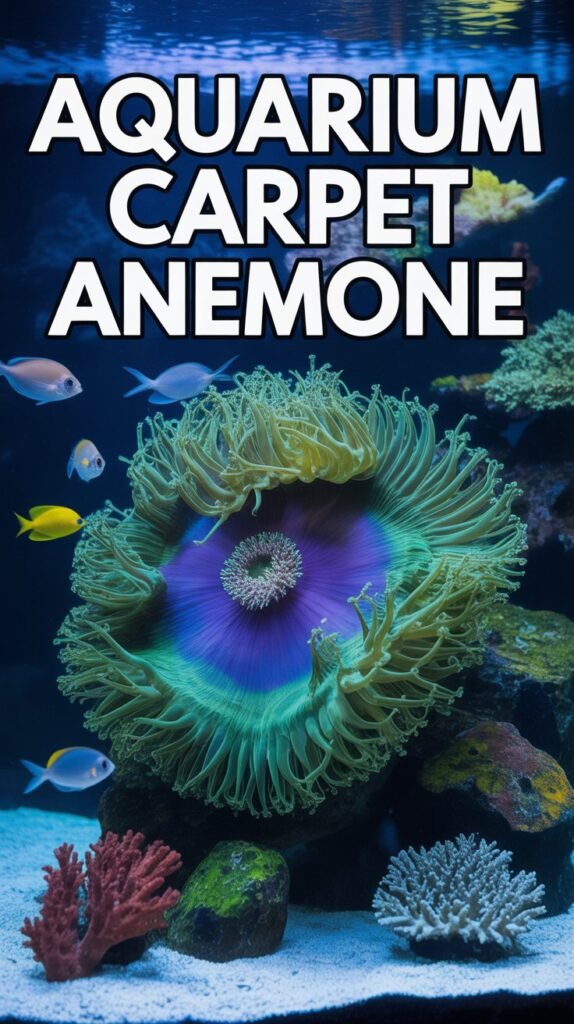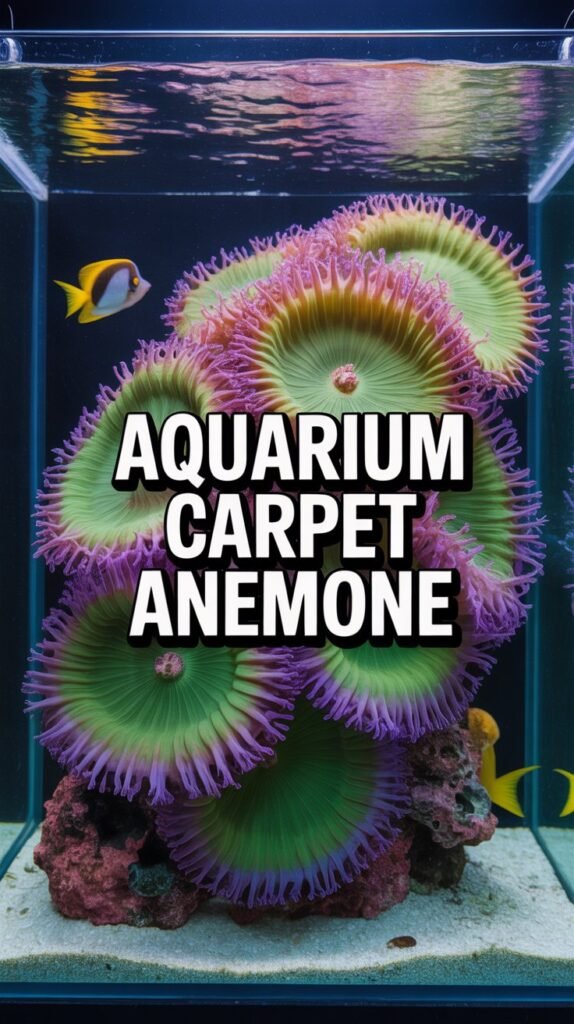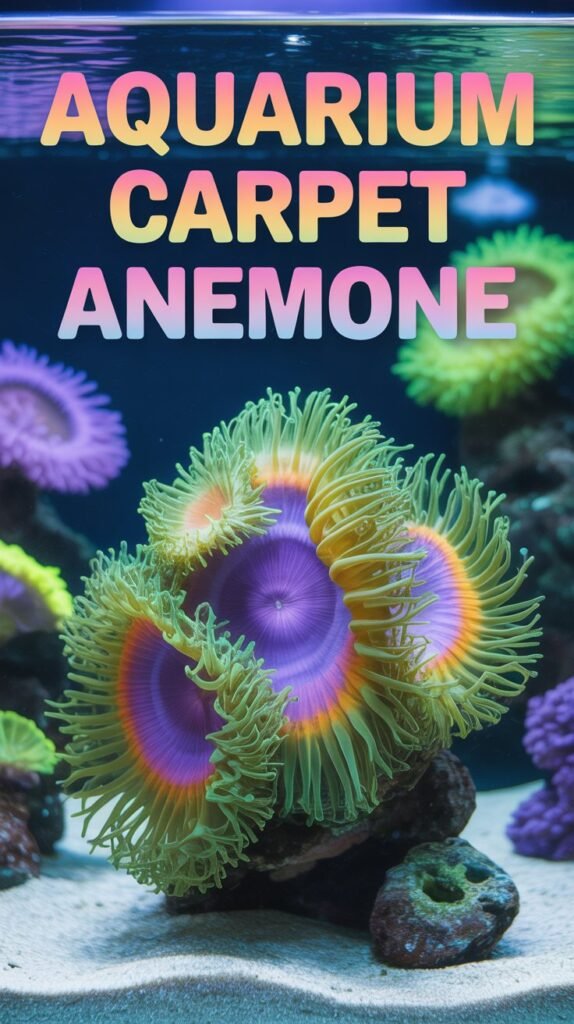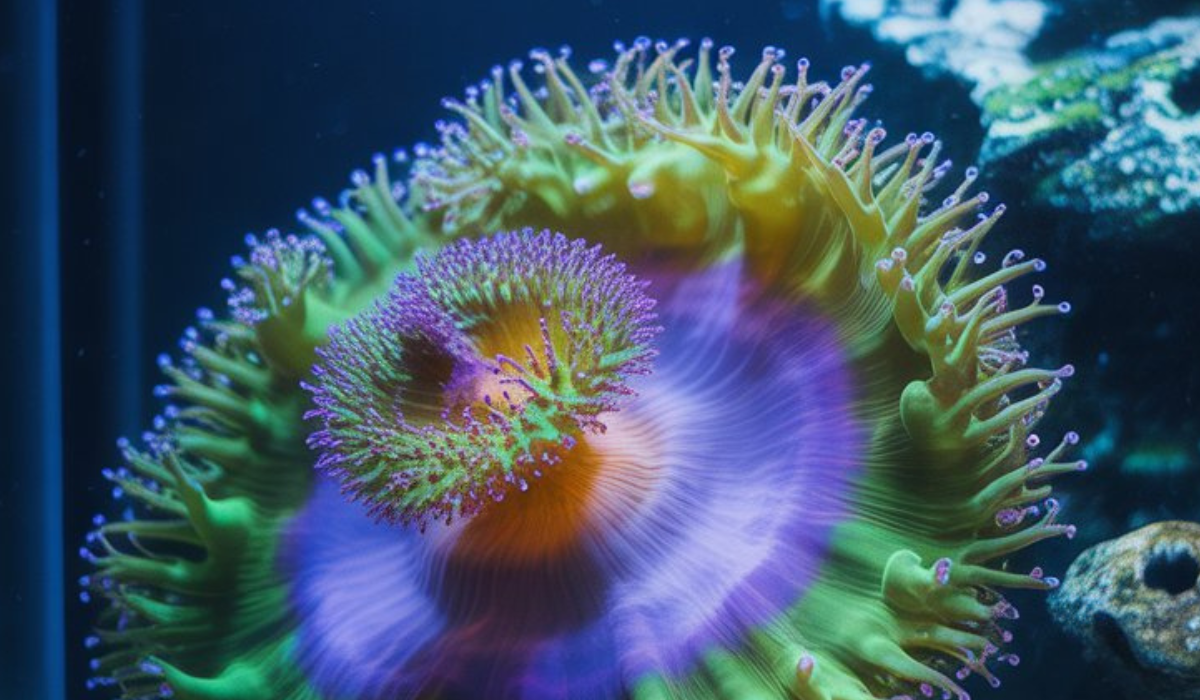The carpet anemone is one of the most stunning and captivating creatures found in marine aquariums. Known for its vibrant colors, wide oral disc, and symbiotic relationship with clownfish, the carpet anemone adds both beauty and ecological balance to saltwater tanks. These large, flat anemones resemble soft carpets gently swaying with ocean currents, hence their name.
While they are mesmerizing to watch, carpet anemones are not the easiest invertebrates to care for. They require stable water parameters, strong lighting, and careful tankmates. In this comprehensive guide, you’ll learn everything you need to know about carpet anemones—from species identification and habitat setup to feeding, compatibility, and health maintenance.
What Is a Carpet Anemone?
Carpet anemones are large sea anemones belonging to the family Stichodactylidae. They are found in shallow, tropical waters across the Indo-Pacific region. Their broad oral disc and sticky tentacles allow them to capture prey efficiently while also hosting symbiotic fish species, most famously clownfish.
Scientific Classification
- Kingdom: Animalia
- Phylum: Cnidaria
- Class: Anthozoa
- Order: Actiniaria
- Family: Stichodactylidae
- Common Name: Carpet Anemone
Carpet anemones are photosynthetic animals that derive energy from zooxanthellae, symbiotic algae living in their tissues. These algae provide nutrients through photosynthesis, while the anemone offers protection and a stable habitat in return.
Types of Carpet Anemones

There are several species of carpet anemones commonly found in the aquarium trade. Each has distinct colors, textures, and care needs.
1. Stichodactyla haddoni (Haddon’s Carpet Anemone)
- Habitat: Found in sandy lagoons or shallow reefs.
- Color: Blue, green, red, or tan.
- Size: Can reach up to 20 inches across.
- Behavior: Semi-aggressive and has a strong sting.
- Notes: Commonly hosts clownfish such as Amphiprion clarkii.
2. Stichodactyla gigantea (Giant Carpet Anemone)
- Habitat: Prefers shallow waters with strong light and gentle flow.
- Color: Purple, blue, brown, or green.
- Size: Can grow over 30 inches across.
- Notes: Requires excellent water quality and intense lighting.
3. Stichodactyla mertensii (Merten’s Carpet Anemone)
- Habitat: Found attached to rocks or coral substrates.
- Color: Brown, tan, or green with distinctive patterns.
- Size: One of the largest species, reaching up to 3 feet across.
- Notes: Hosts a wide variety of clownfish species.
4. Stichodactyla tapetum (Mini Carpet Anemone)
- Habitat: Found in shallow lagoons and reef flats.
- Color: Highly variable—bright green, orange, or purple.
- Size: Usually under 5 inches, ideal for nano reefs.
- Notes: Easier to care for and non-aggressive compared to larger species.
Appearance and Anatomy
Carpet anemones have a broad, circular oral disc covered with thousands of short, sticky tentacles. Their center contains a prominent mouth, which can expand or contract as they feed or expel waste. The tentacles are densely packed and can range in color from vibrant green and blue to golden yellow or pink.
Their underside, known as the pedal disc, is muscular and sticky, allowing the anemone to attach to sand, rock, or glass surfaces. Despite their stationary appearance, they can slowly move to seek better lighting or flow conditions.
Natural Habitat
In the wild, carpet anemones inhabit shallow tropical reefs and sandy lagoons across the Indo-Pacific Ocean—from the Red Sea to Fiji and the Great Barrier Reef. They prefer areas with:
- Moderate water movement
- Bright sunlight
- Fine sand or rocky substrate
- Warm water temperatures (24–28°C / 75–82°F)
Their symbiotic relationship with clownfish is an essential part of coral reef ecosystems. The fish gain protection from predators by hiding among the anemone’s tentacles, while the anemone benefits from food scraps and improved water circulation created by the fish’s movement.
Setting Up a Carpet Anemone Aquarium

Keeping a carpet anemone healthy starts with creating the right environment. These animals are sensitive to changes in water quality and lighting, so careful planning is essential.
1. Tank Size
Carpet anemones require large, mature aquariums with stable parameters.
- Minimum Tank Size: 50 gallons (for small species like S. tapetum)
- Recommended Tank Size: 100 gallons or more for larger species such as S. haddoni or S. gigantea
2. Water Parameters
| Parameter | Ideal Range |
|---|---|
| Temperature | 24°C – 28°C (75°F – 82°F) |
| pH | 8.1 – 8.4 |
| Salinity | 1.024 – 1.026 specific gravity |
| Ammonia | 0 ppm |
| Nitrite | 0 ppm |
| Nitrate | <10 ppm |
| Calcium | 400 – 450 ppm |
| Alkalinity | 8 – 10 dKH |
Stable conditions are more important than chasing perfect numbers. Frequent fluctuations can stress or kill anemones.
3. Lighting
Carpet anemones need strong lighting to support their symbiotic algae. Use high-output LEDs, metal halides, or T5 fixtures that provide full-spectrum illumination. Aim for 8–10 hours of light daily.
Insufficient lighting leads to color fading and starvation, as zooxanthellae provide much of the anemone’s nutrition.
4. Water Flow
Moderate, indirect flow is ideal. Too much flow can cause the anemone to retract or detach, while stagnant areas promote waste buildup. Wavemakers or adjustable pumps can help create natural movement.
5. Substrate
- Haddon’s and Gigantea: Prefer sandy substrates to burrow their base.
- Merten’s: Attaches to rocks or crevices.
- Mini Carpet: Can attach to rock or sand.
Make sure the substrate is fine-grained to prevent injury to the pedal disc.
Acclimating Carpet Anemones
Anemones are extremely sensitive to sudden changes in salinity or temperature. Use a drip acclimation method over 45–60 minutes before introducing them to the tank. Once placed, allow them to attach naturally—avoid forcing them onto rocks or sand.
They may move around for several days before settling. Avoid moving them manually unless absolutely necessary.
Feeding Carpet Anemones
Carpet anemones are opportunistic carnivores that capture prey using their sticky tentacles. They absorb nutrients from both food and their internal algae, so feeding frequency depends on lighting intensity.
Diet Options
Feed your carpet anemone 2–3 times per week with small portions of:
- Mysis shrimp
- Krill
- Chopped fish fillets
- Squid or clam meat
- Enriched brine shrimp
Use feeding tongs to place food near the tentacles. Avoid overfeeding, as uneaten food can decompose and degrade water quality.
Lighting and Photosynthesis
Carpet anemones rely heavily on their zooxanthellae algae, which use light to convert carbon dioxide into sugars. These nutrients sustain the anemone’s basic functions. Strong, high-quality lighting not only enhances coloration but also minimizes the need for frequent feeding.
If the anemone appears pale or whitish, it may be bleaching—a sign that the symbiotic algae have been expelled due to stress or insufficient light. Gradually adjust light intensity rather than making sudden changes.
Tankmates and Compatibility

Carpet anemones are known for their strong sting and territorial nature. They can capture and consume small fish or invertebrates that wander too close. Therefore, tankmate selection is crucial.
Compatible Tankmates:
- Clownfish (e.g., Amphiprion clarkii, A. ocellaris)
- Gobies
- Blennies
- Cleaner shrimp (with caution)
- Other peaceful reef-safe fish that avoid contact
Avoid:
- Butterflyfish (may nip tentacles)
- Angelfish (can harass anemones)
- Large crabs and starfish
- Aggressive species that may attack or disturb the anemone
Hosting Clownfish
Not all clownfish species will accept every carpet anemone. Here’s a compatibility overview:
| Anemone Species | Compatible Clownfish |
|---|---|
| S. haddoni | A. clarkii, A. polymnus, A. sebae |
| S. gigantea | A. percula, A. ocellaris, A. akindynos |
| S. mertensii | Most clownfish species |
| S. tapetum | Usually too small to host clownfish |
Reproduction
Carpet anemones reproduce both sexually and asexually.
1. Sexual Reproduction
Occurs in the wild during spawning events. Male and female anemones release sperm and eggs into the water, where fertilization occurs externally. The resulting larvae settle and grow into new anemones.
2. Asexual Reproduction
Some species can reproduce through fission, where the anemone splits into two identical clones. However, this process is rare in captivity and typically occurs under optimal conditions.
Common Problems and Diseases
Despite their beauty, carpet anemones are sensitive to poor conditions and can develop several health issues.
1. Bleaching
- Cause: Insufficient light or rapid changes in parameters.
- Solution: Gradually increase lighting and ensure stable water quality.
2. Bacterial Infection
- Symptoms: Mouth gaping, slimy body, deflation, or foul odor.
- Solution: Isolate the anemone and perform an iodine or antibiotic dip if recommended by experts. Maintain pristine water conditions.
3. Wandering
Anemones move when unhappy with their position.
- Solution: Adjust lighting, flow, or substrate type. Avoid moving them manually.
4. Predation
Fish or crabs may nip at the anemone’s tentacles.
- Solution: Remove aggressive tankmates and monitor closely.
5. Sudden Collapse
A deflated anemone is not always a bad sign—it may be expelling waste or adjusting to new conditions. However, prolonged collapse indicates stress.
Handling and Safety
Carpet anemones possess powerful stinging cells called nematocysts. While their sting is rarely dangerous to humans, it can cause irritation or allergic reactions.
Handling tips:
- Always use aquarium gloves.
- Avoid prolonged contact with tentacles.
- Do not expose anemones to air for long periods.
Carpet Anemone Color Variants
Color morphs are highly sought after in the aquarium trade. Common variations include:
- Green Carpet Anemone: Vibrant green tentacles with contrasting centers.
- Blue Carpet Anemone: Deep ocean-blue hues; requires strong lighting.
- Purple Carpet Anemone: Rich purple tones; often more delicate.
- Red or Orange Variants: Extremely rare and expensive.
Color intensity often reflects lighting conditions and overall health.
Tips for Success with Carpet Anemones
- Start with a Healthy Specimen: Look for one with a tightly closed mouth, sticky tentacles, and no visible damage.
- Avoid New Tanks: Introduce anemones only after the tank is at least 6 months old and fully cycled.
- Stability is Key: Rapid changes in salinity, pH, or temperature can be fatal.
- Feed Appropriately: Provide small, regular feedings without overloading the system.
- Monitor Behavior: Wandering, gaping mouths, or fading color indicate stress.
- Protect from Powerheads: Cover intakes with mesh to prevent injury.
Carpet Anemones vs. Other Anemones
| Feature | Carpet Anemone | Bubble Tip Anemone | Long Tentacle Anemone |
|---|---|---|---|
| Size | Large (up to 3 feet) | Medium (12–18 inches) | Medium-Large |
| Sting | Strong | Mild | Moderate |
| Lighting Needs | High | Moderate | High |
| Difficulty | Advanced | Beginner-Intermediate | Intermediate |
| Host Clownfish | Yes | Yes | Yes |
Environmental Importance
In the ocean, carpet anemones contribute to reef biodiversity and stability. Their symbiosis with clownfish and cleaner shrimp creates a micro-ecosystem of mutual protection. They also serve as habitats for small crabs and invertebrates, making them essential players in coral reef health.
Frequently Asked Questions (FAQs)
1. Are carpet anemones hard to keep?
Yes, carpet anemones require advanced care due to their sensitivity to water changes and strong lighting needs. They are best suited for experienced marine aquarists.
2. What do carpet anemones eat?
They eat meaty foods such as mysis shrimp, krill, small fish pieces, and squid, along with nutrients produced by symbiotic algae.
3. How big do carpet anemones get?
Depending on the species, they can grow anywhere from 5 inches (mini species) to over 3 feet (giant species) across.
4. Do carpet anemones move around the tank?
Yes, they may move to find better light, flow, or substrate conditions. Ensure they have space to relocate safely.
5. Can I keep more than one carpet anemone in a tank?
It’s not recommended unless the tank is very large. They can sting and damage each other if too close.
6. Do carpet anemones need clownfish to survive?
No, but hosting clownfish can benefit both species. The fish help feed and aerate the anemone.
7. How do I know if my anemone is unhealthy?
Warning signs include a gaping mouth, constant deflation, foul odor, or fading color.
8. Can carpet anemones sting humans?
Yes, their sting can cause mild irritation or rash. Always wear gloves when handling them.
9. How often should I feed my carpet anemone?
Feed small amounts 2–3 times per week under strong lighting conditions.
10. How long do carpet anemones live?
With proper care, carpet anemones can live 10–20 years or more in captivity.
Conclusion
The carpet anemone is one of the ocean’s most remarkable and visually stunning creatures. Its symbiotic bond with clownfish, dazzling colors, and graceful movements make it a prized addition to marine aquariums. However, their demanding care requirements mean they’re best kept by aquarists with experience maintaining stable reef environments.
By providing the right lighting, water quality, and nutrition, you can enjoy the beauty and complexity of a carpet anemone for many years. Whether you choose the small Stichodactyla tapetum or the impressive S. gigantea, these magnificent creatures bring a piece of the coral reef’s magic into your home.

